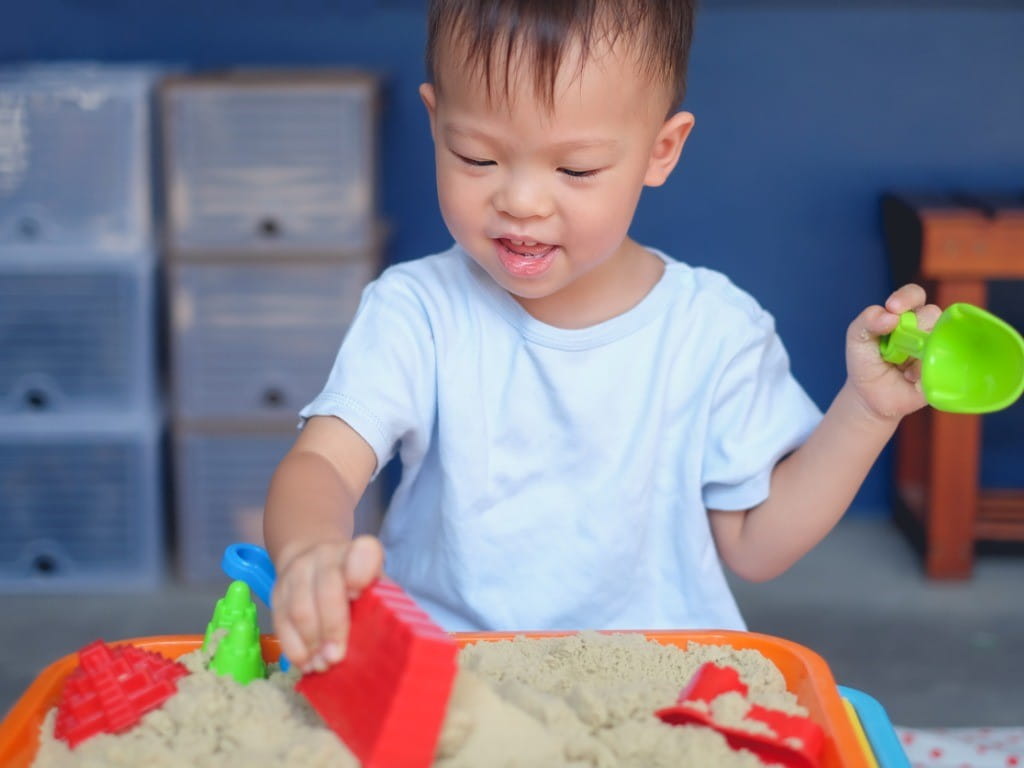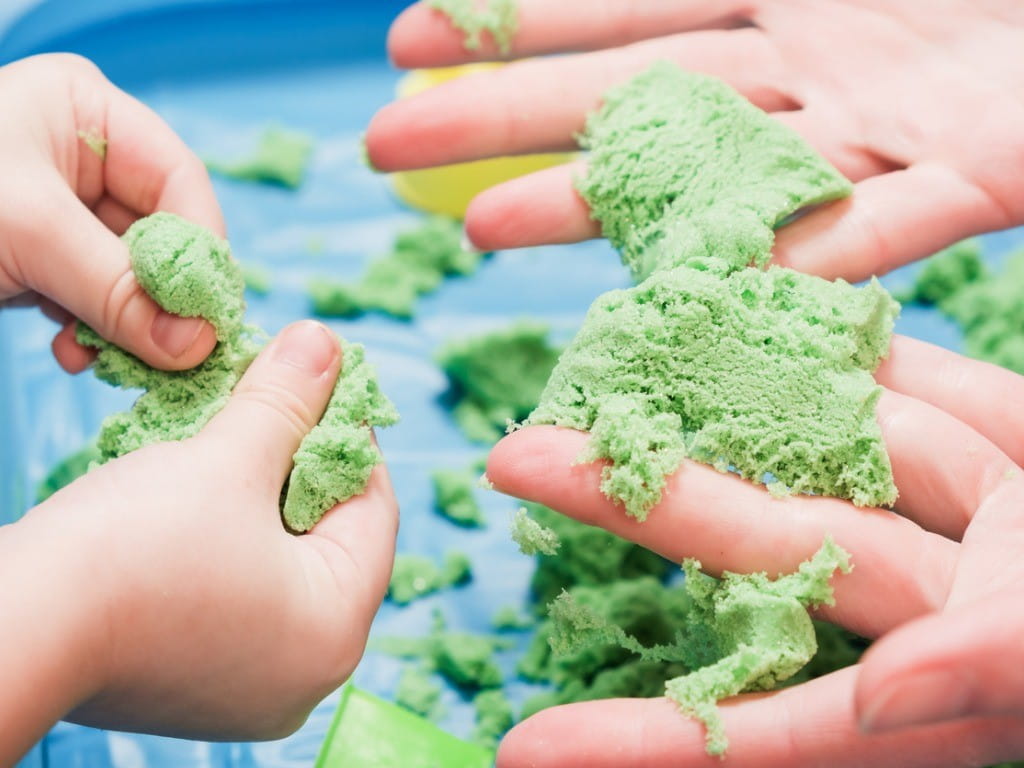Kinetic Sand

The Bottom Line
Kinetic Sand is a fun sensory toy. Sand is not poisonous when swallowed, but it might cause constipation or gastrointestinal obstruction.

What is Kinetic Sand?
Kinetic Sand is made of 98% ultra-fine grain sand combined with 2% dimethicone (polydimethylsiloxane). Dimethicone is a silicone compound that is used in some diaper rash creams and is considered minimally toxic. It is also an important ingredient in Silly Putty! Alone, sand and dimethicone are uninteresting, but the combination is where the magic happens. This mixture creates a moldable solid that can hold a sculpted shape for a short period of time.
When left alone, Kinetic Sand will eventually collapse back into a loose sandy mixture. This happens because Kinetic Sand is a non-Newtonian fluid. A non-Newtonian fluid is a substance that is loose or liquid when left alone, but gets harder under stress, such as when you squeeze it. This property allows Kinetic Sand to be used repeatedly.
Is Kinetic Sand poisonous?
While Kinetic Sand is not poisonous if eaten, it does pose a choking hazard, and if large amounts are eaten, it can cause constipation. In severe cases, it is possible for Kinetic Sand to cause gastrointestinal obstruction. If someone eats a small amount of Kinetic Sand, it should pass in a bowel movement. If the product is uniquely colored, the dye it contains might change the color of the bowel movement. This is not harmful.
Symptoms of a gastrointestinal obstruction include:
- distended or bloated stomach
- lack of bowel movement
- vomiting
- refusal to eat or lack of appetite
- severe constipation
How to make safe Kinetic Sand.
If you can find the ingredients, it is possible to make your own version of Kinetic Sand. Learn how!
My child ate Kinetic Sand. What should I do?
If you suspect someone has ingested Kinetic Sand, check the webPOISONCONTROL online tool for guidance or call Poison Control at 1-800-222-1222Lindsy Liu, PharmD
Certified Specialist in Poison Information
Revised William G. Troutman, PharmD
Professor of Pharmacy Emeritus
Poison Control Media Information
Did you find this page helpful? If so, we need your support. Poison Control is in constant competition with misinformation online. Links to www.poison.org or our webPOISONCONTROL triage tool from other websites and blogs help internet searchers quickly find accurate information and Poison Control’s contact information in an emergency. If you use the content from this page, please provide attribution via a link back to this page, www.poison.org, or https://triage.webpoisoncontrol.org/#!/exclusions. By doing so, you could save a life. Thank you!
Poisoned?
Call 1-800-222-1222 or
Prevention Tips
- Make sure children understand that they should not eat Kinetic Sand.
- Supervise young children when they are playing with Kinetic Sand.
- Keep Kinetic Sand stored out-of-reach of children and pets in a tightly closed container when not in use.
This Really Happened
Case 1. The grandparents of a 2-year-old girl called Poison Control 3 hours after she ate a mouthful of Kinetic Sand. Poison Control reassured the grandparents that the girl should tolerate the ingestion and that no symptoms were expected from this exposure. The girl never developed symptoms.
Case 2. A 4-year-old girl swallowed an unknown amount of green Kinetic Sand. The next day, she had a green-colored bowel movement and was taken to an ER. The ER physician called Poison Control for guidance. Poison Control said that the product was minimally toxic, the discolored stool was expected, and no other symptoms should develop. Other than the green-colored stools, the girl had no symptoms.
For More Information
Widener A. What's that stuff? Magic Sand and Kinetic Sand. Chem Eng News. 2015;93(12):41.
References
Katz DA. Kinetic sand. Wilmington (DE): David A. Katz; 2014 [cited 2020 Aug 29].
Poisoned?
Call 1-800-222-1222 or
Prevention Tips
- Make sure children understand that they should not eat Kinetic Sand.
- Supervise young children when they are playing with Kinetic Sand.
- Keep Kinetic Sand stored out-of-reach of children and pets in a tightly closed container when not in use.
This Really Happened
Case 1. The grandparents of a 2-year-old girl called Poison Control 3 hours after she ate a mouthful of Kinetic Sand. Poison Control reassured the grandparents that the girl should tolerate the ingestion and that no symptoms were expected from this exposure. The girl never developed symptoms.
Case 2. A 4-year-old girl swallowed an unknown amount of green Kinetic Sand. The next day, she had a green-colored bowel movement and was taken to an ER. The ER physician called Poison Control for guidance. Poison Control said that the product was minimally toxic, the discolored stool was expected, and no other symptoms should develop. Other than the green-colored stools, the girl had no symptoms.
